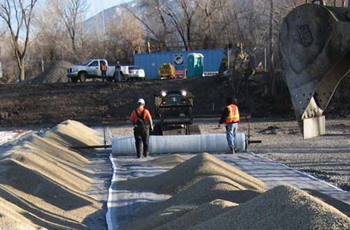 |
Research has shown that Organoclay®, a surface-modified clay, has a high affinity for non-aqueous phase liquid (NAPL) and low solubility dissolved organics. Organoclay has been used successfully for over a decade as a filtration media on offshore oil platforms to remove oil and grease from wastewater prior to discharge to the sea. A layer of Organoclay® can also be incorporated between two geotextiles to form an organoclay Reactive Core Mat® (RCM). Remediation projects have shown that Organoclay® is also applicable for groundwater and soil remediation in the railroad industry.
CASE STUDY
A rail yard in Utah has been in operation since the first transcontinental railroad reached the area in 1869. Four major railroad companies have used the rail yard for switching, maintenance of locomotives, and transferring cargo. Also, on the north side of the yard a Pintsch Gas plant was formerly located. The gas manufacturing system included heating naphtha in cast iron retorts, collecting the purifi ed gas in a condenser and washing the gas with water. A DNAPL tar plume was discovered running from the northern end of the yard under an adjacent highway and into a neighboring pond.
A DNAPL extraction trench was designed to intercept and capture the DNAPL plume. The bottom and downstream side of the extraction trench were lined with 60-mil textured high-density polyethylene (HDPE) geomembrane. Coarse aggregate was used to fill the extraction trench. The trench was capped with 100,000 ft2 of Organoclay® RCM to adsorb any hydrocarbons that diffused upward. The Organoclay® RCM was deployed with a front end loader equipped with a spreader bar assembly consisting of a beam, chains and core pipe. The RCM unrolled as the equipment travels in reverse. The RCM was covered with a 2-ft. layer of permeable material and an 18-in. layer of topsoil.
SUMMARY
Organophilic clays have proven to be effective adsorbent media of non-aqueous phase liquid (NAPL) and low-soluble organic compounds for groundwater, soil and sediment remediation. Recent applications show that organophilic clay can be a valuable tool for remediation design in railroad remediation projects.
DETAILS
Engineers: Kennedy-Jenks; CH2M Hill
Contractor: Envirocon
Geomembrane: 60-mil high-density polyethylene
RCM: 100,000 ft.2 of CETCO Organoclay® Reactive Core Mat®
Learn more about CETCO Remediation Technologies at www.cetco.com/rtg.











